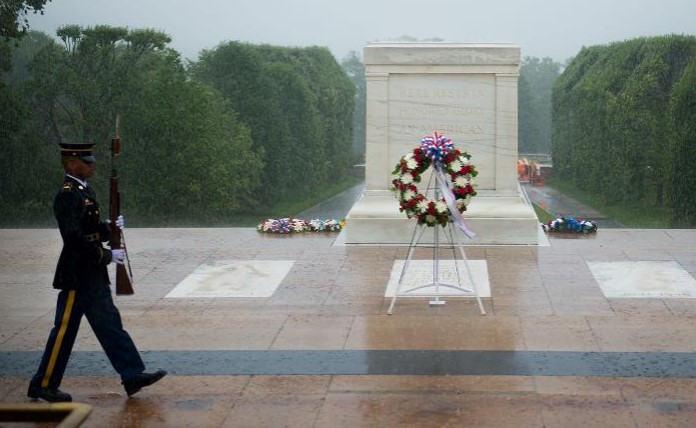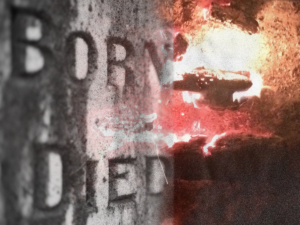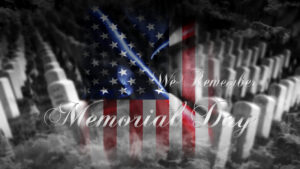Once again, we find ourselves at the beginning of a hotly contested presidential race — made all the more intense by culture wars. What does this have to do with Memorial Day? Some extreme politicians are calling for a divorce of so-called red states and blue states. Since Memorial Day has its roots in the Civil War, it is good time to remember that national divisiveness leads only to human and economic devastation. The staff at the Washington Examiner reminds us, “Memorial Day stemmed from a desire to honor the dead after the Civil War. On May 5, 1868, General John Logan, commander of the Great Army of the Republic through General Order No. 11, selected May 30 as Decoration Day. General Logan chose that date at the time to honor his fallen comrades precisely because no battles took place on that day. He made clear that the purpose of the day was to remember those who had died fighting and to decorate ‘the graves of comrades who died in defense of their country during the late rebellion, and whose bodies now lie in almost every city, village and hamlet churchyard in the land.'”[1] In the aftermath of the First World War, the holiday was adjusted to honor all those who lost their lives in defense of the country and the freedoms we enjoy.
Three of those honored dead lie at rest in the Arlington National Cemetery in the Tomb of the Unknown Soldier monument. The first of those soldiers was interred over a century ago. Journalist Nikki Wentling describes the event:
“A casket containing the unidentified remains of a World War I soldier was carried in a horse-drawn wagon through Washington, D.C., across the Potomac River, and into Arlington National Cemetery on Nov. 11, 1921. Thousands of dignitaries, veterans and American citizens packed into the Memorial Amphitheater at the cemetery, where then-President Warren G. Harding led a state funeral for the unknown soldier. When the ceremony began at noon, bells tolled, and Americans across the country observed two minutes of silence for the fallen man.”
On that occasion, President Harding stated, “The name of him whose body lies before us took flight with his imperishable soul. We know not whence he came, but only that his death marks him with the everlasting glory of an American dying for his country. He might have come from any one of millions of American homes.” On the centennial of that first interment, Karen Durham-Aguilera, who, at the time, was the executive director of Army National Military Cemeteries, stated, “The Tomb of the Unknown Soldier stands, physically and symbolically, at the heart of the cemetery — and the heart of the nation.”[3] The unknown soldier’s remains were retrieved from a cemetery in France and sent by ship to the United States. They arrived in Washington, D.C. on 9 November 1921 and the casket placed in the U.S. Capitol Rotunda. The following day around 90,000 people came to pay their respects before the remains were taken to Arlington the following day.
To ensure the unknown soldier received the dignity and respect he deserved, on 25 March 1926, a daylight hours guard was assigned to his tomb to prevent visitors from climbing or stepping on the tomb. Eleven years later that guard duty become an around-the-clock presence. For over three dozen years, the remains of the World War I soldier laid in solitude in his crypt. Then, in 1956, President Dwight D. Eisenhower signed a bill to select and honor unknown service members from the Second World War and the Korean War, who would then be buried in crypts adjacent to the original Tomb. The U.S. Army reports, “The caskets of the World War II and Korean War Unknowns arrived in Washington on May 28, 1958, where they lay in state in the Capitol Rotunda until the morning of May 30. Reprising the events of 1921, a large ceremonial procession then escorted their caissons to Arlington National Cemetery. President Eisenhower awarded each the Medal of Honor, and the Unknowns of World War II and the Korean War were interred in the plaza beside their World War I comrade.”[4]
The Army notes, “During the Vietnam War era, advances in science and technology made identification of the dead increasingly accurate. By May 1984, only one set of recovered American remains had not been fully identified. These remains were designated as the Unknown Soldier from the Vietnam War. On Memorial Day 1984, an Army caisson carried the Vietnam War Unknown from the U.S. Capitol to Memorial Amphitheater at Arlington National Cemetery, where President Ronald Reagan presided over the interment ceremony and bestowed the Medal of Honor.” As the Army further notes, “For almost 14 years, the Vietnam War Unknown lay at rest at the Tomb. In 1994, Ted Sampley, a POW/MIA activist, determined that the remains were likely those of Air Force 1st Lt. Michael Joseph Blassie. In 1998, DNA testing confirmed Blassie’s identity. At the request of Blassie’s family, the Department of Defense exhumed the remains from the Vietnam War Unknown’s crypt on May 14, 1998. In accordance with the wishes of his family, Blassie was reinterred at Jefferson Barracks National Cemetery in St. Louis, Missouri.”
Today, the Vietnam War Unknown’s crypt remains vacant; however, on 17 September 1999 — National POW/MIA Recognition Day — “it was rededicated to honor all missing U.S. service members from the Vietnam War. The slab over the crypt that once held the remains of the Vietnam War Unknown has since been replaced. The original inscription of ‘Vietnam’ has been changed to ‘Honoring and Keeping Faith with America’s Missing Servicemen’ — a reminder of the commitment of the Armed Forces to the fullest possible accounting for missing service members.”[5]
As we honor our fallen heroes, we should never forget the freedoms and love of country for which they fought and died. Memorial Day marks the unofficial beginning of summer, let’s hope the summer heat comes from natural sunlight and not from political dogfights — especially those that would once again divide the country and lead to bloodshed.
Footnotes
[1] Staff, “Why you shouldn’t confuse Memorial Day and Veterans Day,” Washington Examiner, 28 May 2017.
[2] Nikki Wentling, “100 years of the Tomb of the Unknown Soldier,” Stars and Stripes, 8 November 2021.
[3] Ibid.
[4] Staff, “History: A Brief Timeline of the Tomb of the Unknown Soldier,” U.S. Army.
[5] Ibid.





